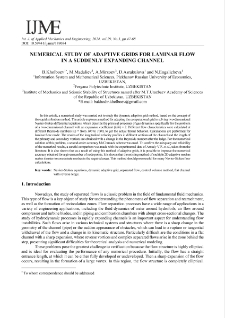Digital Library of Zielona Góra contains 63 482 digital objects
Object
Title: Numerical study of adaptive grids for laminar flow in a suddenly expanding channel
Creator:
Kholboev, Bakhodir Murodovich ; Asrakulova, Dono Sunnatullaevna ; Engalicheva, Nelia Rustamovna ; Madaliev, Murodil Erkinjon ugli ; Mirzoev, Akmal Ahadovich
Date:
Resource Type:
Contributor:
Group publication title:
Abstract:
In this article, a numerical study was carried out to study the dynamic adaptive grid method, based on the concept of the equidistribution method. The article explores a method for adapting the computational grid to solving two-dimensional Navier-Stokes differential equations, which describe the physical processes of gas dynamics specifically for the problem of a two-dimensional channel with an expansion coefficient (H/h) = 2. ; Different flow characteristics were calculated at different Reynolds numbers Re = from 100 to 1000, to get the actual thread behavior. Calculations are performed for laminar flow mode. The results of the longitudinal velocity profiles in different sections of the channel and the length of the primary and secondary vortices are obtained with a change in the Reynolds number after the ledge. ; For the numerical solution of this problem, a second-order accuracy McCormack scheme was used. To confirm the adequacy and reliability of the numerical results, a careful comparison was made with the experimental data of Armaly V.F. et al., taken from the literature. It is also shown that as a result of using this method of adaptive grids, it is possible to improve the numerical accuracy obtained for a given number of node points. ; It is shown that the existing method of multiple 2D adaptive meshes makes it easier to concentrate meshes in the required areas. This method should prove useful for many Navier-Stokes flow calculations.
Publisher:
Zielona Góra: Uniwersytet Zielonogórski
Format:
Resource Identifier:
DOI:
Pages:
Source:
IJAME, volume 29, number 3 (2024)
Language:
License:
License CC BY-NC-ND 4.0:
Rights:
Biblioteka Uniwersytetu Zielonogórskiego
Object collections:
- Digital Library of Zielona Góra > Repository > Faculties > Faculty of Mechanical Engineering
- Digital Library of Zielona Góra > Repository > Types of work > Articles
- Digital Library of Zielona Góra > Repository > Scientific journals and UZ publishing series > International Journal of Applied Mechanics and Engineering (IJAME)
- Digital Library of Zielona Góra > Repository > Scientific journals and UZ publishing series > International Journal of Applied Mechanics and Engineering (IJAME) > International Journal of Applied Mechanics and Engineering (IJAME) (2024)
Last modified:
Dec 16, 2024
In our library since:
Sep 13, 2024
Number of object content hits:
166
All available object's versions:
https://zbc.uz.zgora.pl/publication/90108
Show description in RDF format:
Show description in OAI-PMH format:
| Edition name | Date |
|---|---|
| Numerical study of adaptive grids for laminar flow in a suddenly expanding channel | Dec 16, 2024 |
Objects Similar
Kholboev, Bakhodir Murodovich Malikov, Zafar M. Madaliev, Murodil Erkinjon ugli Shoev, Mardon Masharipov, Sirojiddin Jurczak, Paweł - red.
Kholboev, Bakhodir Murodovich Navruzov, Dilshod Primkulovich Asrakulova, Dono Sunnatullaevna Engalicheva, Nelia Rustamovna Turemuratova, Ariukhan Abatbayevna Jurczak, Paweł - red.
Aboula?ch, Rajae Azelmat, Karim Baranger, Jacques Souissp, Ali Korbicz, Józef (1951- ) - red. Uciński, Dariusz - red.
Ciesielski, Mariusz Domański, Zbigniew Mochnacki, Bohdan Kuczma, Mieczysław - red.

